Sphinx
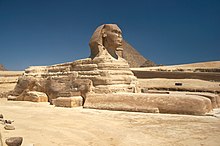 The Great Sphinx of Giza, with the Great Pyramid in the background. | |
| Grouping | Legendary creatures |
|---|---|
| Sub grouping | Mythological hybrids |
| Similar creatures | Griffin, manticore |
| Mythology | Persian, Egyptian and Greek |
A sphinx (Ancient Greek: Σφίγξ [spʰíŋks], Boeotian: Φίξ [pʰíːks], plural sphinxes or sphinges) is a mythical creature with the head of a human and the body of a lion.
In Greek tradition, it has the head of a human, the haunches of a lion, and sometimes the wings of a bird. It is mythicised as treacherous and merciless. Those who cannot answer its riddle suffer a fate typical in such mythological stories, as they are killed and eaten by this ravenous monster.[1] This deadly version of a sphinx appears in the myth and drama of Oedipus.[2] Unlike the Greek sphinx, which was a woman, the Egyptian sphinx is typically shown as a man (an androsphinx (Ancient Greek: Ανδρόσφιγξ)). In addition, the Egyptian sphinx was viewed as benevolent, but having a ferocious strength similar to the malevolent Greek version and both were thought of as guardians often flanking the entrances to temples.[3]
In European decorative art, the sphinx enjoyed a major revival during the Renaissance. Later, the sphinx image, something very similar to the original Ancient Egyptian concept, was exported into many other cultures, albeit often interpreted quite differently, due to translations of descriptions of the originals and the evolution of the concept in relation to other cultural traditions.
Sphinxes depictions are generally associated with architectural structures such as royal tombs or religious temples. The oldest known sphinx was found near Gobekli Tepe at another site, Nevali Çori,[4] or possibly 195 kilometres (120 mi) to the east at Kortik Tepe, Turkey, and was dated to 9,500 B.C.[5][better source needed]
Contents
1 Egypt
2 Greece
2.1 Riddle of the Sphinx
3 South and Southeast Asia
4 Europe
5 Freemasonry
6 In popular culture
7 Similar creatures
8 Gallery
9 See also
10 Notes
11 References
12 Further reading
13 External links
Egypt
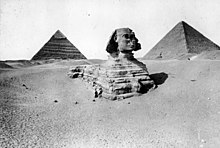
Great Sphinx before clearance, Brooklyn Museum Archives

Back of the Great Sphinx, Giza, Egypt
The largest and most famous sphinx is the Great Sphinx of Giza, situated on the Giza Plateau adjacent to the Great Pyramids of Giza on the west bank of the Nile River and facing east (29°58′31″N 31°08′15″E / 29.97528°N 31.13750°E / 29.97528; 31.13750). The sphinx is located southeast of the pyramids. Although the date of its construction is uncertain, the head of the Great Sphinx now is believed to bear the likeness of the pharaoh Khafra.
What names their builders gave to these statues is not known. At the Great Sphinx site, a 1400 B.C. inscription on a stele belonging to the 18th dynasty pharaoh Thutmose IV lists the names of three aspects of the local sun deity of that period, Khepera–Rê–Atum. Many pharaohs had their heads carved atop the guardian statues for their tombs to show their close relationship with the powerful solar deity Sekhmet, a lioness. Besides the Great Sphinx, other famous Egyptian sphinxes include one bearing the head of the pharaoh Hatshepsut, with her likeness carved in granite, which is now in the Metropolitan Museum of Art in New York, and the alabaster sphinx of Memphis, Memphis, Egypt, currently located within the open-air museum at that site. The theme was expanded to form great avenues of guardian sphinxes lining the approaches to tombs and temples as well as serving as details atop the posts of flights of stairs to very grand complexes. Nine hundred sphinxes with ram heads, representing Amon, were built in Thebes, where his cult was strongest.
The Great Sphinx has become an emblem of Egypt, frequently appearing on its stamps, coins, and official documents.[6]
Greece
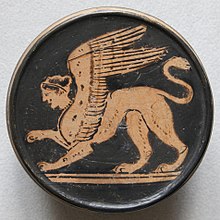
Sphinx. Attic red-figure pyxis, 2nd half of the 5th century BC. From Nola (Italy)
In the Bronze Age, the Hellenes had trade and cultural contacts with Egypt. Before the time that Alexander the Great occupied Egypt, the Greek name, sphinx, was already applied to these statues. The historians and geographers of Greece wrote extensively about Egyptian culture. Herodotus called the ram-headed sphinxes Criosphinxes and called the hawk-headed ones Hieracosphinxes.
In Greek mythology, a sphinx is represented as a monster with a head of a woman, the body of a lioness, the wings of an eagle, and a serpent-headed tail.
The word sphinx comes from the Greek Σφίγξ, apparently from the verb σφίγγω (sphíngō), meaning "to squeeze", "to tighten up".[7][8] This name may be derived from the fact that, in a pride of lions, the hunters are the lionesses, and kill their prey by strangulation, biting the throat of prey and holding them down until they die. However, the historian Susan Wise Bauer suggests that the word "sphinx" was instead a Greek corruption of the Egyptian name "shesepankh", which meant "living image", and referred rather to the statue of the sphinx, which was carved out of "living rock" (rock that was present at the construction site, not harvested and brought from another location), than to the beast itself.[9]
There was a single sphinx in Greek mythology, a unique demon of destruction and bad luck. According to Hesiod, she was a daughter of Orthrus[10] and either Echidna or the Chimera, or perhaps even Ceto;[11] according to others, she was a daughter of Echidna and Typhon. All of these are chthonic figures from the earliest of Greek myths, before the Olympians ruled the Greek pantheon. The Sphinx is called Phix (Φίξ) by Hesiod in line 326 of the Theogony, the proper name for the Sphinx noted by Pierre Grimal's The Penguin Dictionary of Classical Mythology.
The sphinx was the emblem of the ancient city-state of Chios, and appeared on seals and the obverse side of coins from the 6th century B.C. until the 3rd century CE.
Riddle of the Sphinx

Archaic period Greek sphinx in the Corinth Archaeological Museum
The Sphinx is said to have guarded the entrance to the Greek city of Thebes, asking a riddle to travellers to allow them passage. The exact riddle asked by the Sphinx was not specified by early tellers of the myth, and was not standardized as the one given below until late in Greek history.[12]

The Sphinx of Naxos, on its 12.5 meters Ionic column, Delphi, 560 B.C. (reconstitution).
It was said in late lore that Hera or Ares sent the Sphinx from her Aethiopian homeland (the Greeks always remembered the foreign origin of the Sphinx) to Thebes in Greece where she asked all passersby the most famous riddle in history: "Which creature has one voice and yet becomes four-footed and two-footed and three-footed?" She strangled and devoured anyone who could not answer. Oedipus solved the riddle by answering: "Man—who crawls on all fours as a baby, then walks on two feet as an adult, and then uses a walking stick in old age".[13] By some accounts[14] (but much more rarely), there was a second riddle: "There are two sisters: one gives birth to the other and she, in turn, gives birth to the first. Who are the two sisters?" The answer is "day and night" (both words—ἡμέρα and νύξ, respectively—are feminine in Ancient Greek). This second riddle is also found in a Gascon version of the myth and could be very ancient.[15]
Bested at last, the Sphinx then threw herself from her high rock and died. An alternative version tells that she devoured herself. In both cases, Oedipus can therefore be recognized as a "liminal" or threshold figure, helping effect the transition between the old religious practices, represented by the death of the Sphinx, and the rise of the new, Olympian gods.
In Jean Cocteau's retelling of the Oedipus legend, The Infernal Machine, the Sphinx tells Oedipus the answer to the riddle in order to kill herself so that she did not have to kill anymore, and also to make him love her. He leaves without ever thanking her for giving him the answer to the riddle. The scene ends when the Sphinx and Anubis ascend back to the heavens.
There are mythic, anthropological, psychoanalytic and parodic interpretations of the Riddle of the Sphinx, and of Oedipus's answer to it. Sigmund Freud describes "the question of where babies come from" as a riddle of the Sphinx.[16]
Numerous riddle books use the Sphinx in their title or illustrations.[17]
Michael Maier, in his book the Atalanta Fugiens (1617)[18] writes the following remark about the Sphinx's riddle, in which he states that its solution is the Philosopher's Stone:
Sphinx is indeed reported to have had many Riddles, but this offered to Oedipus was the chief, "What is that which in the morning goeth upon four feet; upon two feet in the afternoon; and in the Evening upon three?" What was answered by Oedipus is not known. But they who interpret concerning the Ages of Man are deceived. For a Quadrangle of Four Elements are of all things first to be considered, from thence we come to the Hemisphere having two lines, a Right and a Curve, that is, to the White Luna; from thence to the Triangle which consists of Body, Soul and Spirit, or Sol, Luna and Mercury. Hence Rhasis in his Epistles, "The Stone," says he, "is a Triangle in its essence, a Quadrangle in its quality."

Funerary stele, 530 BCE, Greece.

Limestone funerary stele (shaft) surmounted by two sphinxes Greece 5th century BCE.

Marble capital and finial in the form of a sphinx, 530 B.C.

Sphinxes on the Lycian sarcophagus of Sidon (430-420 BC)
South and Southeast Asia

Buddhist sphinx on a stupa gateway, Bharhut, 1st century B.C.[19]
A composite mythological being with the body of a lion and the head of a human being is present in the traditions, mythology and art of South and Southeast Asia.[20] Variously known as purushamriga (Sanskrit, "man-beast"), purushamirugam (Tamil, "man-beast"), naravirala (Sanskrit, "man-cat") in India, or as nara-simha (Sanskrit, "man-lion") in Sri Lanka, manusiha or manuthiha (Pali, "man-lion") in Myanmar, and norasingh (from Pali, "man-lion", a variation of the Sanskrit "nara-simha") or thep norasingh ("man-lion deity"), or nora nair in Thailand.
In contrast to the sphinxes in Egypt, Mesopotamia, and Greece, of which the traditions largely have been lost due to the discontinuity of the civilization,[21] the traditions related to the "Asian sphinxes" are very much alive today. The earliest artistic depictions of "sphinxes" from the South Asian subcontinent are to some extent influenced by Hellenistic art and writings. These hail from the period when Buddhist art underwent a phase of Hellenistic influence. Numerous sphinxes can be seen on the gateways of Bharhut stupa, dating to the 1st Century B.C.[19]
In South India, the "sphinx" is known as purushamriga (Sanskrit) or purushamirugam (Tamil), meaning "human-beast". It is found depicted in sculptural art in temples and palaces where it serves an apotropaic purpose, just as the "sphinxes" in other parts of the ancient world.[22] It is said by the tradition, to take away the sins of the devotees when they enter a temple and to ward off evil in general. It is therefore often found in a strategic position on the gopuram or temple gateway, or near the entrance of the Sanctum Sanctorum.

Male purushamriga or Indian sphinx guarding the entrance of the Shri Shiva Nataraja temple in Chidambaram
The purushamriga plays a significant role in daily as well as yearly ritual of South Indian Shaiva temples. In the shodhasha-upakaara (or sixteen honors) ritual, performed between one and six times at significant sacred moments through the day, it decorates one of the lamps of the diparadhana or lamp ceremony. And in several temples the purushamriga is also one of the vahana or vehicles of the deity during the processions of the Brahmotsava or festival.

Burmese depiction of the Manussiha
In Kanya Kumari district, in the southernmost tip of the Indian subcontinent, during the night of Shiva Ratri, devotees run 75 kilometres while visiting and worshiping at twelve Shiva temples. This Shiva Ottam (or Run for Shiva) is performed in commemoration of the story of the race between the Sphinx and Bhima, one of the heroes of the epic Mahabharata.
The Indian conception of a sphinx that comes closest to the classic Greek idea is in the concept of the Sharabha, a mythical creature, part lion, part man and part bird, and the form of Sharabha that god Shiva took on to counter Narasimha's violence.
In Sri Lanka and India,[citation needed] the sphinx is known as narasimha or man-lion. As a sphinx, it has the body of a lion and the head of a human being, and is not to be confused with Narasimha, the fourth reincarnation of the deity Vishnu; this avatar or incarnation is depicted with a human body and the head of a lion. The "sphinx" narasimha is part of the Buddhist tradition and functions as a guardian of the northern direction and also was depicted on banners.
In Burma, the sphinx is known as manussiha (manuthiha). It is depicted on the corners of Buddhist stupas, and its legends tell how it was created by Buddhist monks to protect a new-born royal baby from being devoured by ogresses.
Nora Nair, Norasingh and Thep Norasingh are three of the names under which the "sphinx" is known in Thailand. They are depicted as upright walking beings with the lower body of a lion or deer, and the upper body of a human. Often they are found as female-male pairs. Here, too, the sphinx serves a protective function. It also is enumerated among the mythological creatures that inhabit the ranges of the sacred mountain Himapan.[23]
Europe
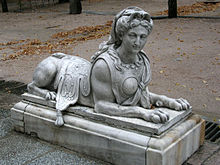
La Granja, Spain, mid-18th century
The revived Mannerist sphinx of the late 15th century is sometimes thought of as the "French sphinx". Her coiffed head is erect and she has the breasts of a young woman. Often she wears ear drops and pearls as ornaments. Her body is naturalistically rendered as a recumbent lioness. Such sphinxes were revived when the grottesche or "grotesque" decorations of the unearthed Domus Aurea of Nero were brought to light in late 15th-century Rome, and she was incorporated into the classical vocabulary of arabesque designs that spread throughout Europe in engravings during the 16th and 17th centuries. Sphinxes were included in the decoration of the loggia of the Vatican Palace by the workshop of Raphael (1515–20), which updated the vocabulary of the Roman grottesche.
The first appearances of sphinxes in French art are in the School of Fontainebleau in the 1520s and 1530s and she continues into the Late Baroque style of the French Régence (1715–1723). From France, she spread throughout Europe, becoming a regular feature of the outdoors decorative sculpture of 18th-century palace gardens, as in the Upper Belvedere Palace in Vienna, Sanssouci Park in Potsdam, La Granja in Spain, Branicki Palace in Białystok, or the late Rococo examples in the grounds of the Portuguese Queluz National Palace (of perhaps the 1760s), with ruffs and clothed chests ending with a little cape.

Caresses (1896) by Fernand Khnopff, a Symbolist depiction of Oedipus and the Sphinx[24]
Sphinxes are a feature of the neoclassical interior decorations of Robert Adam and his followers, returning closer to the undressed style of the grottesche. They had an equal appeal to artists and designers of the Romanticism and subsequent Symbolism movements in the 19th century. Most of these sphinxes alluded to the Greek sphinx and the myth of Oedipus, rather than the Egyptian, although they may not have wings.
Freemasonry

Sphinx adopted as an emblem in Masonic architecture
The sphinx image also has been adopted into Masonic architecture. Among the Egyptians, sphinxes were placed at the entrance of the temples to guard their mysteries, by warning those who penetrated within that they should conceal a knowledge of them from the uninitiated. Champollion said that the sphinx became successively the symbol of each of the gods. The placement of the sphinxes expressed the idea that all the gods were hidden from the people, and that the knowledge of them, guarded in the sanctuaries, was revealed to initiates only. As a Masonic emblem, the sphinx has been adopted in its Egyptian character as a symbol of mystery, and as such often is found as a decoration sculptured in front of Masonic temples, or engraved at the head of Masonic documents. It cannot, however, be properly called an ancient, recognized symbol of the order. Its introduction has been of comparatively recent date, and rather as a symbolic decoration than as a symbol of any particular dogma.[citation needed]
In popular culture
- In the 1968 animated film Asterix and Cleopatra, Obelix scales the Great Sphinx of Giza, causing its nose to break off.
- The 1992 animated film Aladdin depicts the construction of the Great Sphinx of Giza. In the film, a man is carving the Sphinx's human face just as Aladdin flies by on a flying carpet. The sight proves such a distraction to the sculptor that he mis-hits the great statue, causing its nose to break off.
- The Sphinx as a monster make appearances in the fourth installment of both the Harry Potter and the Percy Jackson & the Olympians series, both novels involving the main protagonists confronting her in a maze.
- The Sphinx also makes an appearance in the 2016 film Gods of Egypt, where it is voiced and motion-captured by Kenneth Ransom. It is found in Set's pyramid and poised to kill any who cannot solve its riddle:
.mw-parser-output .templatequote{overflow:hidden;margin:1em 0;padding:0 40px}.mw-parser-output .templatequote .templatequotecite{line-height:1.5em;text-align:left;padding-left:1.6em;margin-top:0}
I never was, am always to be. No one ever saw me, nor ever will, and yet, I am the confidence of all who live and breathe. What am I?
Horus and the character Bek bring Thoth, the god of wisdom, with them, sure he will be able to solve whatever riddle is posed. Thoth stumbles at first, offering order and other suggestions before landing on, at the last second, the correct answer: tomorrow. The Sphinx expresses its disappointment before residing.
Similar creatures
- The 32,000-year-old Aurignacian Löwenfrau goddess is the oldest known anthropomorphic statue. Previously known as the Lion-man, she has a human female body and a lioness head.
- Not all human-headed animals of antiquity are sphinxes.[citation needed] In ancient Assyria, for example, bas-reliefs of shedu bulls with the crowned bearded heads of kings guarded the entrances of temples.
- The Iranian Gopat or Gopaitioshah is another creature that is similar to the Sphinx, being a winged bull/lion with human face.[25][26] The Gopat have been represented in ancient art of Iran since late second millennium BC, and was a common symbol for dominant royal power in ancient Iran. Gopats were common motifs in the art of Elamite period, Luristan, North and North West region of Iran in Iron Age, and Achaemenid art,[27] and can be find in texts such as the Bundahishn, the Dadestan-i Denig, the Menog-i Khrad, as well as in collections of tales, such as the Matikan-e yusht faryan and in its Islamic replication, the Marzubannama.[28]
- The Manticore (Early Middle Persian: Mardyakhor or Martikhwar, means: Man-eater[29]) is an Iranian legendary hybrid creature and another similar creature to the sphinx.
- Many Greek mythological creatures who are archaic survivals of previous mythologies with respect to the classical Olympian mythology, like the centaurs, are similar to the Sphinx.
Narasimha ("man-lion") is described as an incarnation (Avatar) of Vishnu within the Puranic texts of Hinduism who takes the form of half-man/half-Asiatic lion, having a human torso and lower body, but with a lion-like face and claws.
Gallery

Maned sphinx of Amenemhat III. 12th Dynasty, c. 1800 BC. State Museum of Egyptian Art, Munich

Egyptian sphinx from Hadrian's Villa at Tivoli. 1st century AD. State Museum of Egyptian Art, Munich
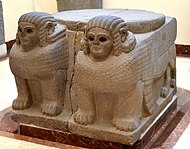
Column base in the shape of a double sphinx. From Sam'al. 8th century BC. Museum of the Ancient Orient, Istanbul

Hittite sphinx. Basalt. 8th century BC. From Sam'al. Museum of the Ancient Orient, Istanbul

Winged sphinx from the palace of Darius the Great during Persian Empire at Susa (480 B.C.)

Head from a female sphinx, c. 1876–1842 B.C., Brooklyn Museum

The Great Sphinx of Giza in 1858

Typical Egyptian sphinx with a human head (Museo Egizio, Turin)

Sphinx of Egyptian pharaoh Hatshepsut with unusual ear and ruff features, 1503–1482

Ancient Greek sphinx from Delphi

3000-year-old sphinxes were imported from Egypt to embellish public spaces in Saint Petersburg and other European capitals.

Park Sanssouci in Potsdam
Queluz wingless rococo sphinx
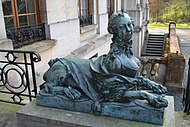
Classic Régence garden Sphinx in lead, Château Empain, the Parc d'Enghien, Belgium

Park Schönbusch in Aschaffenburg, Bavaria, 1789–90
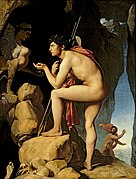
Ingres, Oedipus and the Sphinx

Symbolist Oedipus and the Sphinx by Gustave Moreau

Sphinx at Plaza de los Emperadores (Parque de El Capricho, Madrid)

Marble sphinx on a cavetto capital, Attic, c. 580–575 B.C.
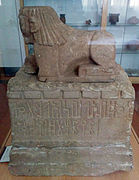
The Sphinx of Adi Gramaten, Eritrea
Wings of sphinxes from the Thinissut sanctuary, c. 1st century CE (Nabeul Museum, Tunisia)

An early Egyptian sphinx, Queen Hetepheres II from the Fourth Dynasty (Cairo Museum)

Picture of an Iranian Elamite Gopat on a seal, currently in the National Museum of Iran.
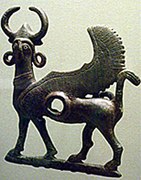
An Iranian Luristan Bronze in the form of a Gopat, currently in the Cleveland Museum of Art.

Picture of a Gopat on a golden rython from Amarlou, Iran, currently in the National Museum of Iran.
See also
| Wikimedia Commons has media related to Sphinxes. |
- Hybrid creatures in mythology
- List of hybrid creatures in mythology
Similar hybrid creatures
Anzû (older reading: Zû), Mesopotamian monster
Chimera, Greek mythological hybrid monster
Cockatrice, snake with rooster's head and feet and bat's wings
Dragon, European and East Asian reptile-like mythical creature
Griffin or griffon, lion-bird hybrid
Harpy, Greco-Roman mythological bird monster with woman's face
Lamassu, Assyrian deity, bull/lion-eagle-human hybrid
Manticore, Persian monster with a lion's body and a humanoid head.
Nue, Japanese legendary creature
Pegasus, winged stallion in Greek mythology
Phoenix, self-regenerating bird in Greek mythology
Pixiu or Pi Yao, Chinese mythical creature
Qilin, Chinese/East Asian mythical hybrid creature
Sharabha, Hindu mythology: lion-bird hybrid
Simurgh, Iranian mythical flying creature
Sirin, Russian mythological creature, half-woman half-bird
Snow Lion, Tibetan mythological celestial animal
Yali, Hindu mythological lion-elephant-horse hybrid
Ziz, giant griffin-like bird in Jewish mythology
Komainu to compare its use in Japanese culture
Chinthe similar lion statues in Burma, Laos and Cambodia
Shisa similar lion statues in the Ryukyu Islands
Nian to compare with a similar but horned (unicorn) mythical beast
Haetae to compare with similar lion-like statues in Korea.
Notes
^ "Dr. J's Lecture on Oedipus and the Sphinx". People.hsc.edu. Retrieved 2014-05-15..mw-parser-output cite.citation{font-style:inherit}.mw-parser-output q{quotes:"""""""'""'"}.mw-parser-output code.cs1-code{color:inherit;background:inherit;border:inherit;padding:inherit}.mw-parser-output .cs1-lock-free a{background:url("//upload.wikimedia.org/wikipedia/commons/thumb/6/65/Lock-green.svg/9px-Lock-green.svg.png")no-repeat;background-position:right .1em center}.mw-parser-output .cs1-lock-limited a,.mw-parser-output .cs1-lock-registration a{background:url("//upload.wikimedia.org/wikipedia/commons/thumb/d/d6/Lock-gray-alt-2.svg/9px-Lock-gray-alt-2.svg.png")no-repeat;background-position:right .1em center}.mw-parser-output .cs1-lock-subscription a{background:url("//upload.wikimedia.org/wikipedia/commons/thumb/a/aa/Lock-red-alt-2.svg/9px-Lock-red-alt-2.svg.png")no-repeat;background-position:right .1em center}.mw-parser-output .cs1-subscription,.mw-parser-output .cs1-registration{color:#555}.mw-parser-output .cs1-subscription span,.mw-parser-output .cs1-registration span{border-bottom:1px dotted;cursor:help}.mw-parser-output .cs1-hidden-error{display:none;font-size:100%}.mw-parser-output .cs1-visible-error{font-size:100%}.mw-parser-output .cs1-subscription,.mw-parser-output .cs1-registration,.mw-parser-output .cs1-format{font-size:95%}.mw-parser-output .cs1-kern-left,.mw-parser-output .cs1-kern-wl-left{padding-left:0.2em}.mw-parser-output .cs1-kern-right,.mw-parser-output .cs1-kern-wl-right{padding-right:0.2em}
^ Kallich, Martin. "Oepidus and the Sphinx." Oepidus: Myth and Drama. N.p.: Western, 1968. N. pag. Print.
^ Stewart, Desmond. Pyramids and the Sphinx. [S.l.]: Newsweek, U.S., 72. Print.
^ "Is The Sphinx 12 000 Years Old?". Dailyavocado.net. 2011-01-27. Archived from the original on 24 June 2011. Retrieved 2014-05-15.CS1 maint: Unfit url (link) Archived.
^ Nicholas Birch in Istanbul (2008-04-23). "Birch, N., 7000 Years Older Than Stonehenge: The Site that Stunned Archaeologists, The Guardian, April 2008". Guardian. Retrieved 2014-05-15.
^ Regier, Willis Goth. Book of the Sphinx (Lincoln: University of Nebraska Press, 2004), 54, 59, 177.
^ Entry σφίγγω at LSJ.
^ Note that the γ takes on a 'ng' sound in front of both γ and ξ.
^ Bauer, S. Wise (2007). The History Of The Ancient World. New York: W. W. Norton & Company, Inc. pp. 110–112. ISBN 0-393-05974-X.
^ Hesiod, Theogony 327
^ Who is meant as the mother is unclear, the problem arising from the ambiguous referent of the pronoun "she" in line 326 of the Theogony, see Clay, p.159, note 34
^ Edmunds, Lowell (1981). The Sphinx in the Oedipus Legend. Königstein im Taunus: Hain. ISBN 3-445-02184-8.
^ Apollodorus, Library Apollod. 3.5.8
^ Grimal, Pierre (1996). The Dictionary of Classical Mythology. trans. A. R. Maxwell-Hyslop. Blackwell Publishing. ISBN 0-631-20102-5. (entry "Oedipus", p. 324)
^ Julien d'Huy (2012). L'Aquitaine sur la route d'Oedipe? La Sphinge comme motif préhistorique. Bulletin de la SERPE, 61: 15-21.
^ 'An Autobiographical Study', Sigmund Freud, W. W. Norton & Company, 1963, p.39
^ Regier, Book of the Sphinx, chapter 4.
^ Maier, Michael (1617). Atalanta Fugiens. trans. Peter Branwin. Johann Theodor de Bry.
^ ab "Sphinxes of all sorts occur on the Bharhut gateways" Kosambi, Damodar Dharmanand (2002). Combined Methods in Indology and Other Writings. Oxford University Press. p. 459. ISBN 9780195642391.
^ Deekshitar, Raja. "Discovering the Anthropomorphic Lion in Indian Art." in Marg. A Magazine of the Arts. 55/4, 2004, p.34-41; Sphinx of India.
^ Demisch, Heinz (1977). Die Sphinx. Geschichte ihrer Darstellung von den Anfangen bis zur Gegenwart. Stuttgart.
^ Demisch, Heinz (1977). Die Sphinx. Geschichte ihrer Darstellung von den Anfangen bis zur Gegenwart. Stuttgart.
^ "Thep Norasri". Himmapan.com. Retrieved 2014-05-15.
^ Royal Museums of Fine Arts of Belgium (2017). "Caresses". Google Arts and Culture.
^ "Dadestan-i Denig, Question 90, Paragraph 4".
^ "Menog-i Khrad, Chapter 62".
^ Taheri, Sadreddin (2017). "The Semiotics of Archetypes, in the Art of Ancient Iran and its Adjacent Cultures". Tehran: Shour Afarin Publications.
^ Taheri, Sadreddin (2013). "Gopat and Shirdal in the Near East". Tehran: Honarhay-e Ziba Journal, Vol. 17, No. 4.
^ Pausanias, Pausanias, Description of Greece, 9.21.4
References
- Clay, Jenny Strauss, Hesiod's Cosmos, Cambridge University Press, 2003.
ISBN 978-0-521-82392-0.
- Stewart, Desmond. Pyramids and the Sphinx. [S.l.]: Newsweek, U.S., 72. Print.
Taheri, Sadreddin (2013). "Gopat (Sphinx) and Shirdal (Gryphon) in the Ancient Middle East". Tehran: Honarhay-e Ziba Journal, Vol. 17, No. 4.
- Kallich, Martin. "Oedipus and the Sphinx." Oedipus: Myth and Drama. N.p.: Western, 1968. N. pag. Print.
Further reading
- Dessenne, André. Le Sphinx: Étude iconographique (in French). De Boccard, 1957.
External links
- Sphinx Head Found in Greek Tomb
The Sphinx: Totally Random Trivia - slideshow by Life magazine





























